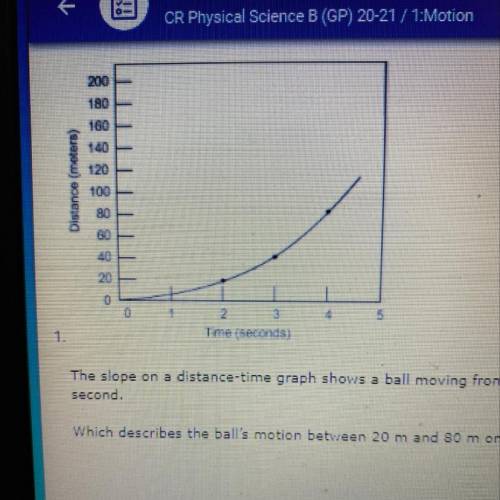
Physics, 06.04.2021 20:10 shaferxspecial3737
Time (seconds)
The slope on a distance-time graph shows a ball moving from 20 m to 40 min 1s and from 40 m to 30 m in the next
second.
Which describes the ball's motion between 20 m and 80 m on the graph?
O nonlinear, acceleration
O nonlinear constant speed
O linear, acceleration
© linear constant speed


Answers: 2


Another question on Physics

Physics, 22.06.2019 11:30
Why is the energy that results from a roller coaster's position at the top of a hill referred to as potential energy?
Answers: 1


Physics, 22.06.2019 12:00
Ihave a density of 1.61g/cm^3 and a mass of 28g. find the missing value
Answers: 1

Physics, 22.06.2019 17:40
You throw a baseball directly upward at time =0 at an initial speed of 14.9 m/s. what is the maximum height the ball reaches above where it leaves your hand? ignore air resistance and take =9.80 m/s2.
Answers: 1
You know the right answer?
Time (seconds)
The slope on a distance-time graph shows a ball moving from 20 m to 40 min 1s and fr...
Questions

Physics, 29.09.2019 04:10


Mathematics, 29.09.2019 04:10


Mathematics, 29.09.2019 04:10


English, 29.09.2019 04:10



Mathematics, 29.09.2019 04:20

Mathematics, 29.09.2019 04:20

Mathematics, 29.09.2019 04:20


Engineering, 29.09.2019 04:20

Biology, 29.09.2019 04:20

Mathematics, 29.09.2019 04:20


Arts, 29.09.2019 04:20





